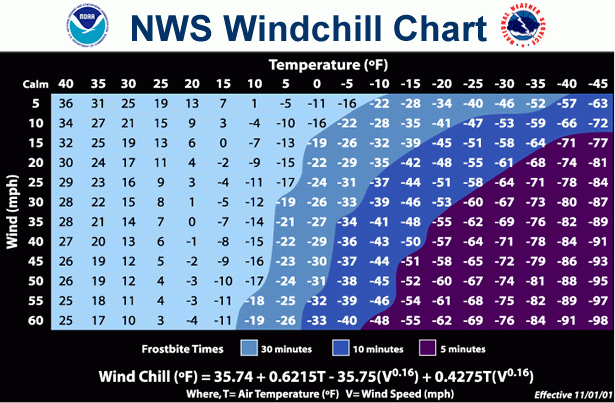As the wind is howling outside today, its unfortunately apparent that we aren’t quite done with winter and cold temps here.
With that being said, if people in the Midwest waited for perfect weather to exercise, they would almost never do it. Intense weather is something that avid runners have learned to deal with. But there is a difference between bad weather and dangerous weather.
An important indicator of if it is okay to run is the wind chill, something northerners are all-too familiar with. Just because the thermometer says its 3 degrees, doesn’t mean it feels like 3 degrees. Wind chill takes into consideration what the temperature will feel like based on wind speeds and moisture. Wind chill temperatures are what will determine if you will get frostbite or not. If the thermometer says 20 degrees, but the wind chill is 0 degrees, your skin will freeze as though it is 0 degrees.
The image above from buisnessinsider.com shows how long you can be outside in specific temperatures. Look at the temperature compared to the wind speed to find the wind chill. The color of the graph will tell you the amount of time you should be outside. A good rule of thumb is if it is less than 20 degrees, never be outside for more than 30 minutes!
Staying Safe in Harsh Weather
If you are one who chooses to brave the cold and go outside during the winter, you will want to make sure that you are doing so safely. Working out in the cold can be dangerous, as you risk frostbite and put extra strain on your heart and lungs. Here are some tips on how to stay safe when you are outside during the winter.
Layer
Wear at least 2-3 layers of warm clothing. Try and wear fabrics that will insulate heat as your base layer. This will prevent heat from escaping your body. Make sure that the top layer is always a windbreaker. Wearing windbreakers prevent you from experiencing the harsh wind chill. It is important that you layer so that you have items to take off. As odd as it may sound, overheating is a big problem that occurs in winter runners.
Cover everything
A majority of your body heat escapes through your head and feet. It is important to ensure that these areas are properly covered to allow your body to stay warm. Your ears, ankles, and fingers are most septuple to frostbite, so make sure that those areas are covered especially well.
No Cotton
Amongst outdoor trainers, runners, and hikers there is a saying that “cotton is rotten”. This is because cotton soaks up sweat instead of allowing it to dry properly. This will make your skin damp which will lead to excessive cooling and put you at greater risk of frostbite. Instead, try a fabric that is moisture-wicking!
Take extra time to warm up
Your body will be slow to warm up in the winter. If you start running outside right away, it can take your body up to 15 minutes to heat up in the winter. Running “cold” could lead to muscle strain or cause injury. Try doing jumping jacks, running in place, or jumping rope indoors to allow your muscles to be warm before the run.
Go at the right time of day
Even if it doesn’t always seem like it, it is warmer in the day than it is at night. Because of this, it is important to run during the light times of the days to ensure that it is warmer. Many people lack vitamin D during the winter, so it is also beneficial to catch much needed sunlight during your runs.
Getting outdoors to exercise even in the winter brings about many benefits. Remembering these tips will make it more enjoyable and reduce your risks.

